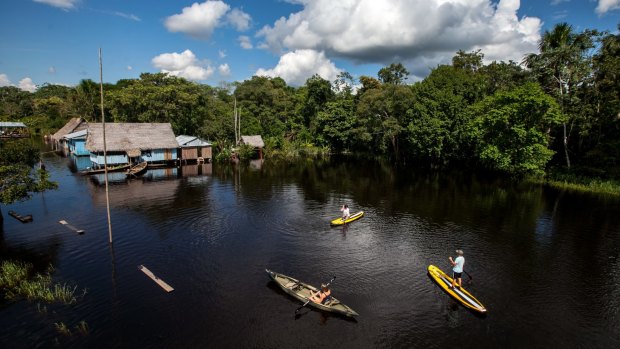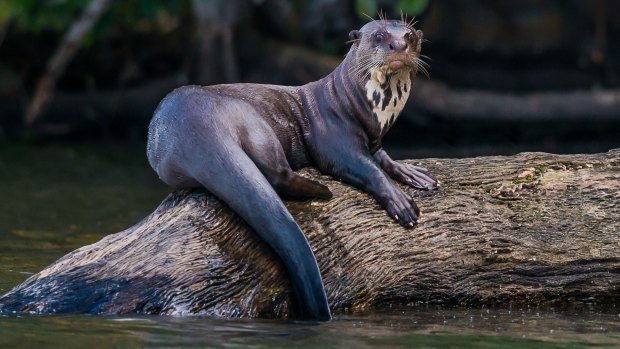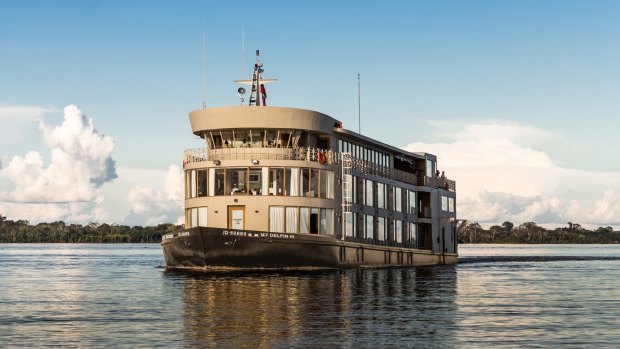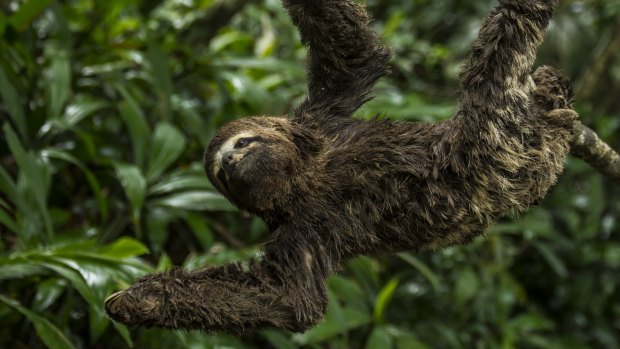This was published 4 years ago
Amazon river cruises, Peru: Into the home of the superfoods

Kayaking on the Pacaya River is a delight.
The Amazon is renowned for its abundant wildlife, both animal and plant varieties, and much has been written about superfoods and natural medicines that originate in the Amazon basin.
On the way from the little airport at Iquitos, in north-eastern Peru, to board river ship Delfin III at the town of Nauta – a 95-kilometre journey south through thick rainforest and ramshackle villages along a rutted red road – one of the Delfin guides makes an early start on educating us about these local treasures.
Jairo ("just call me Hero") Flores stops the minibus and leaps off to buy a bunch of aguaje at a roadside stand. As we give the scaly, dark-red palm-tree fruit a taste test he explains the yellowy-orange pulp is used for a variety of purposes.

A giant otter.Credit: iStock
Because the pulp is so rich in vitamins A and C, proteins and oils, it can be used to treat burns and skin conditions such as psoriasis and eczema; its phytoestrogens are used in supplements to correct hormonal imbalances. It's also used to make ice-cream (which we sample onboard the ship, delicious), jams, soft and alcoholic drinks.
We absorb more interesting info-snippets along the way. Iquitos, the gateway to the Peruvian Amazon, is the largest city in the world that's inaccessible by road. It is built on three rivers, the Amazon, Itaya and Nanay, is well-known for the floating markets of Belen and in recent years travellers have flocked to the city in search of shamans who administer ayahuasca, a natural hallucinogenic potion.
Our group of cruisers, a 20-strong contingent including Yale University alumni, two Australians and me, might be keen to delve into ayahusaca's mystical properties if we had a couple of weeks to spend vomiting and transforming our lives but now is not that time.

The Delfin III.
We are greeted at Nauta's riverside embarkation lounge by Delfin III's enthusiastic cruise manager, Ricardo "Ricky" Urunaga, and whisked off to the ship on high-powered skiff boats. Even though you know the Amazon is arguably the longest river in the world, when you see its vast, reflective expanses and enormous skies for the first time it takes you completely by surprise.
No time is wasted on this short cruise – soon after we embark and unpack we're off on a late-afternoon skiff excursion into jungle-clad creeks running off the swollen river. It's high-water season and the trees are alive with birds – even on this hour-long trip Delfin's eagle-eyed naturalist guides point out hawks, fork-tailed flycatchers, eastern kingbirds, white-winged and southern-rough-winged swallows and more.
The ship's wildlife-spotting checklist proves invaluable for recaps over the course of our time on the river because we see so many birds, mammals and reptiles that it's impossible to keep track of all the sightings at the time. I fill a small notebook and take hundreds of photos but realise very quickly that my camera is not up to the job and that I'd left my binoculars on a previous cruise. A fellow passenger's smartphone takes better pictures and I resolve to upgrade as soon as I return home.

Three-toed sloths hang from the trees.Credit: iStock
Despite this handicap I observe three-toed sloths hanging from the tops of tall trees; squirrel, red howler and saddleback tamarin monkeys jumping through the jungle, on several occasions startlingly close to our skiffs dawdling along the riverbank; neon-green iguanas and, once, a dark-grey, two-metre mussurana snake; plus 25 more species of birds, including numerous kingfishers, parrots and vibrant blue-and-yellow macaws.
Wake-up calls are at 6am. Woven into days spent exploring the waterways are cultural lectures and culinary demonstrations onboard. Our education about Amazonian superfoods continues with a fascinating show, tell and eat session starring exotic-looking fruits and vegetables, presented by naturalist Rody Flores.
Rody tells us that there are more than 120 different species of Amazonian fruits and many are now cultivated for the international superfood-supplement market. We sample camu camu, masato, sapote, ice-cream beans ("jungle candy"), a local variety of cacao and star fruit, all of which are incorporated in Delfin III's remarkable cuisine.
Rody knows his stuff; he spent eight years living and working with a shaman in the wilderness. Cruise director Urunaga elaborates: "Shamans, or curanderos, are known as the healers of the Amazon rainforest. They are born with the knowledge and the gift of saving or healing people through ancestral knowledge of medicinal plants and many years of experience. Using hallucinogenic plants, they can see people's futures and this can have a big, positive impact on people's lives."
On the second evening, we go fishing in swampy lagoons a short skiff ride from Delfin III's mooring. As the light fades a chorus of calls from frogs, cicadas, bats and birds fills the air and when Jairo sweeps the reed beds surrounding the boat with a spotlight we see a flash of golden eyes – it's a black caiman that disappears in an instant.
Using basic poles and lines, we effortlessly land fish that our guides identify and then throw back, among them sabalo and red-bellied piranhas. Like most people who know nothing much about fish, I am under the impression that piranhas are man-eating creatures that shred anything fleshy to the bone – in fact Jairo says they are pretty harmless, despite their razor-sharp teeth.
This is reassuring to know as we have a day exploring in the Pacaya Samiria National Reserve coming up, which includes "optional swimming" and kayaking. The reserve spans more than two million hectares and is the largest protected flooded forest in the world. Among the flora and fauna living in this extraordinarily biodiverse region are pink dolphins which, according to local legend, have supernatural seductive powers.
It's certainly a thrill when we spot one or two near the ship but swimming among dozens of them in a lake on the Pacaya River is mesmerising – so much so that even passengers who were reluctant to dive in initially don't want the experience to end.
Kayaking on the river is another delight. The current makes the trip along the glossy, khaki-coloured water more of a leisurely glide than a work-out and I share my kayak with an inspirational man in his 80s who is busy planning what to do with his life for the next 20 years. He's happy to have ticked off the Peruvian Amazon but has many more places on his travel to-do list.
Although we only see a few local inhabitants passing by on boats, some 100,000 riberenos, or river-dwellers, live along the riverbanks within the Pacaya Samiria reserve. Delfin works closely with local communities. The naturalist guides and ships' crews, whose knowledge of the river's prolific wildlife is phenomenal, are all from the area. They help educate other locals about the importance of protecting the ecosystem from increasing threats of deforestation and mining pollution.
On a smaller scale, the delicate artworks you see on the ship's dining tables and in your cabin are created by local women, in partnership with Delfin co-founder Lissy Urteaga. Even if you can't bring one home (because they're made from fibre and bark) buy one, take a photo and enjoy the memory – every little bit makes a difference.
FIVE THINGS TO KNOW BEFORE YOU GO
WHEN TO CRUISE
The Amazon has two seasons, flooded (November to May) and dry (June to October) and is hot year-round. Even in the dry season there is still significant rainfall. Whenever you go, you'll see incredible plants, birds and animals but the flooded season is best for exploring the waterways by canoe and skiff.
VITAL STATISTICS
Whether the Amazon or the Nile is the world's longest river is open to debate – however the Amazon runs 6840 kilometres west to east from the Peruvian Andes and across Peru, Ecuador, Colombia, Venezuela, Bolivia and Brazil. It empties into the Atlantic Ocean on the north-eastern coast of Brazil.
PACKING ESSENTIALS
Whatever season you go, take the best camera you can and/or a good pair of binoculars. Also take a small waterproof bag for your camera, lightweight hiking shoes, a swimsuit, breathable long-sleeve shirts, insect repellent, sunblock and a hat.
PAPERWORK
If you're visiting as a tourist for less than six months, you don't need a visa but your passport must be valid for at least six months. Entry permission is granted on arrival. Visa and other entry and exit conditions (such as currency, customs and quarantine regulations) can change at short notice. Contact the Embassy of Peru for up-to-date information. see embaperu.org.au/embassy/visas.html
HEALTH ADVISORY
The potentially fatal disease yellow fever is widespread but preventable by vaccination. You need to present a valid yellow fever vaccination certificate on entry into Australia if you've visited Peru in the previous six days. Also check with your doctor whether you need anti-malarial medication.
TRIP NOTES
Sally Macmillan was a guest of Eclipse Travel.
MORE
CRUISE
Delfin operates three ships on the Peruvian Amazon: Delfin I (eight guests), Delfin II (28 guests) and Delfin III (43 guests). Delfin III offers three- and four-night itineraries year-round. Fares for Delfin III's three-night cruise start from $US2550 a person in 2020 and include excursions, soft and selected alcoholic drinks and transfers from/to Iquitos airport on recommended flights. See eclipsetravel.com.au
Sign up for the Traveller Deals newsletter
Get exclusive travel deals delivered straight to your inbox. Sign up now.